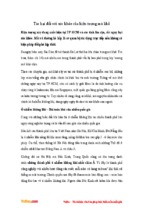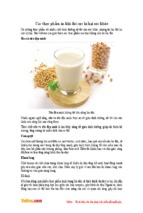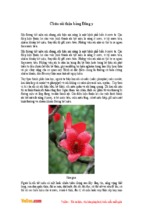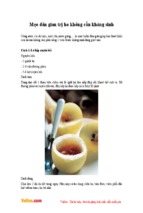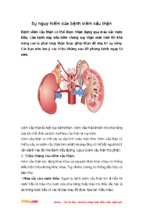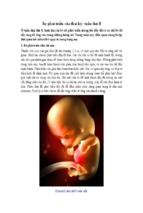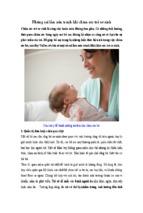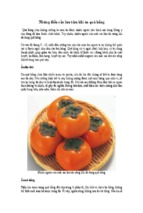Kiểm soát đường huyết nội viện
Inpatient glycaemic
management
The right clinical information, right where it's needed
Last updated: Oct 09, 2017
Table of Contents
Summary
3
Basics
4
Definition
4
Epidemiology
4
Aetiology
4
Pathophysiology
5
Classification
5
Prevention
Screening
Diagnosis
8
8
9
Case history
9
Step-by-step diagnostic approach
9
Risk factors
10
History & examination factors
11
Diagnostic tests
12
Differential diagnosis
14
Treatment
16
Step-by-step treatment approach
16
Treatment details overview
22
Treatment options
23
Emerging
33
Follow up
34
Recommendations
34
Complications
34
Prognosis
34
Guidelines
36
Diagnostic guidelines
36
Treatment guidelines
36
Online resources
38
Evidence scores
39
References
41
Disclaimer
45
Summary
◊ Patients with newly discovered hyperglycaemia have significantly higher in-hospital mortality than
patients with a known history of diabetes or normoglycaemic patients.
◊ Increasing evidence indicates that the development of hyperglycaemia during acute medical or
surgical illness is not a physiological or benign condition, but is a marker of poor clinical outcome and
mortality.
◊ Both hyperglycaemia and hypoglycaemia are associated with higher mortality, independent of known
history of diabetes.
◊ Effective management of hyperglycaemia is associated with a decreased length of ICU and hospital
stay. Tight glycaemic control in the normal range of 4.4 mmol/L to 6.1 mmol/L (80-110 mg/dL) may
not be necessary, however, and may be harmful.
◊ A basal-bolus insulin regimen or a basal insulin regimen may be used in patients admitted to hospital
who are not critically ill, but sliding scale insulin alone should not be used in these patients.
Inpatient glycaemic management
Basics
BASICS
Definition
Inpatient glycaemic management refers to identifying and treating hyperglycaemia in the setting of acute
illness in hospitalised patients with either pre-existing diabetes or new-onset hyperglycaemia. This may occur
in the ICU or in the general ward, and evidence and guidelines differ between these settings. The 3 groups of
patients to consider are the following:
-Known diabetes mellitus before admission.
-New diagnosis of diabetes mellitus made on admission to hospital: in these cases patients are not aware
they have diabetes but present with hyperglycaemia, and diabetes is diagnosed subsequently.
-Transient hyperglycaemia: this may be related to stress, drug therapy such as corticosteroids, or parenteral
and enteral nutrition, and resolves when the inciting factor is removed.
The prevention and management of hypoglycaemia in the inpatient setting is also addressed. Diabetic
ketoacidosis and non-ketotic hyperosmolar hyperglycaemia are not specifically addressed.
Epidemiology
Inpatient hyperglycaemia is relatively common. With the increase in obesity and diabetes in the general
population, it is likely that a growing proportion of patients admitted to hospital will have hyperglycaemia.
In one study, hyperglycaemia was present in 38% of patients admitted to hospital (26% with a known
history of diabetes; 12% with no history of diabetes before admission).[4] Patients with newly discovered
hyperglycaemia have been shown to have a significantly higher in-hospital mortality (16%) than patients who
have a history of diabetes (3%) or people with normoglycaemia (1.7%).[5]
Aetiology
Increasing evidence indicates that the development of hyperglycaemia during acute medical or surgical
illness is not a physiological or benign condition but is a marker of poor clinical outcome and increased
mortality.[4] [6] [7]
Identification that treating hyperglycaemia may improve clinical outcomes has brought more attention to
this field. The aetiology of inpatient hyperglycaemia is multi-factorial and involves increases in circulating
concentrations of stress hormones, along with possible deleterious effects on vascular, haemodynamic,
and immune systems.[8] In some cases the hyperglycaemia may be due to concomitant therapy, such as
corticosteroids, or to parenteral, and occasionally enteral, nutrition. Hyperglycaemia has been associated
with an increased risk of complications and mortality in patients on parenteral nutrition.[9]
A blood glucose of <3.9 mmol/L (<70 mg/dL) is often used to define hypoglycaemia, and <2.2 mmol/L (<40
mg/dL) for severe hypoglycaemia. Hypoglycaemia is a known adverse effect of insulin and other antidiabetic
medications. In addition, patients at increased risk of hypoglycaemia include those with reduced nutritional
intake, malnutrition, renal or hepatic impairment, heart failure, malignancy, infection, sepsis, older age, and
cognitive impairment.[1] [10] [11]
4
This PDF of the BMJ Best Practice topic is based on the web version that was last updated: Oct 09, 2017.
BMJ Best Practice topics are regularly updated and the most recent version
of the topics can be found on bestpractice.bmj.com . Use of this content is
subject to our disclaimer. © BMJ Publishing Group Ltd 2017. All rights reserved.
Inpatient glycaemic management
Basics
Pathophysiology
Concomitant treatments often exacerbate the problem. Corticosteroid therapy that induces insulin resistance
is a good example. In addition, parenteral nutrition with a high fat load leads to increased free fatty acids,
which in turn affect glucose metabolism.
Hyperglycaemia has multiple consequences, which may affect clinical outcomes. These include altered white
blood cell function, blood flow and reactivity, and oxidative stress. Thus, correction of hyperglycaemia is
theoretically appealing.[12]
Classification
Transient hyperglycaemia
Development of hyperglycaemia is related to the onset of stress (e.g., infection or MI), drugs such as
corticosteroids, or enteral and parenteral nutrition, with resolution when the inciting factor is removed.
Tests:
• HbA1c is normal if the period of stress or exposure is short (reflecting normal blood glucose before the
illness).
Type 1 diabetes mellitus[1]
May have a genetic predisposition and usually presents at a young age (5-15 years old). May have history of
polyuria, polydipsia, and unintentional weight loss.
Tests:
Two out of the following tests, or the same test performed twice if the patient does not have unequivocal
symptoms of hyperglycaemia:
• Fasting plasma glucose: ≥7 mmol/L (≥126 mg/dL)
• Oral glucose tolerance test: 2-hour plasma glucose ≥11.1 mmol/L (≥200 mg/dL). This test is generally
not necessary
• HbA1c ≥48 mmol/mol (≥6.5%).
In a patient with unequivocal symptoms of hyperglycaemia:
• Random plasma glucose ≥11.1 mmol/L (≥200 mg/dL).
Supporting evidence for type 1 diabetes:
• Plasma and urine ketones: elevated in ketoacidosis
• Fasting C-peptide: usually low but may be in the normal range
This PDF of the BMJ Best Practice topic is based on the web version that was last updated: Oct 09, 2017.
BMJ Best Practice topics are regularly updated and the most recent version
of the topics can be found on bestpractice.bmj.com . Use of this content is
subject to our disclaimer. © BMJ Publishing Group Ltd 2017. All rights reserved.
5
BASICS
Hyperglycaemia in patients admitted to hospital, with or without a previous history of diabetes, is a complex
condition, usually associated with both insulin resistance and insulin deficiency. Insulin resistance is often
related to inflammation induced by infections or stress hormones and cytokines. Some of these same factors
affect pancreatic beta-cell function and induce insulin deficiency.
Inpatient glycaemic management
Basics
BASICS
• Anti-glutamic acid decarboxylase (GAD) antibodies, islet cell antibodies (ICA), insulinoma-associated
protein-2 (IA-2) antibodies: positive.
Type 2 diabetes mellitus[1] [2]
Usually older age. May have family history. Higher risk in black, Latino, and Native American people.
May have features of metabolic syndrome (hypertension, obesity, and hyperlipidaemia).
Polyuria, polydipsia, and unintentional weight loss may occur.
May have indication of associated insulin resistance: for example, acanthosis nigricans or polycystic ovary
syndrome (PCOS).[1]
Tests:
Two out of the following tests, or the same test performed twice if the patient does not have unequivocal
symptoms of hyperglycaemia:
• Fasting plasma glucose: ≥7 mmol/L (≥126 mg/dL)
• Oral glucose tolerance test: 2-hour plasma glucose ≥11.1 mmol/L (≥200 mg/dL). This test is generally
not necessary
• HbA1c ≥48 mmol/mol (≥6.5%).
In a patient with unequivocal symptoms of hyperglycaemia:
• A random plasma glucose ≥11.1 mmol/L (≥200 mg/dL).
Pre-diabetes[1]
Risk factors and history similar to those of type 2 diabetes.
Tests:
• Impaired fasting glucose: fasting plasma glucose 5.55 mmol/L to 6.9 mmol/L (100-125 mg/dL)
• Impaired glucose tolerance: oral glucose tolerance test 2-hour plasma glucose 7.8 mmol/L to 11 mmol/
L (140-199 mg/dL)
• HbA1c: 38 mmol/mol to 47 mmol/mol (5.7-6.4%).
Diabetes presenting during pregnancy[1]
The current definition is presented; however, the rest of the topic is intended to reflect non-pregnant patients.
In the past, this term was used for diabetes that was first recognised during pregnancy. In 2010, this was
changed to reflect the following:
• Overt diabetes – this is diagnosed at the initial antenatal visit when any one of the following has been
satisfied:
• Fasting plasma glucose ≥7 mmol/L (≥126 mg/dL)
• HbA1c ≥48 mmol/mol (≥6.5%)
6
This PDF of the BMJ Best Practice topic is based on the web version that was last updated: Oct 09, 2017.
BMJ Best Practice topics are regularly updated and the most recent version
of the topics can be found on bestpractice.bmj.com . Use of this content is
subject to our disclaimer. © BMJ Publishing Group Ltd 2017. All rights reserved.
Inpatient glycaemic management
Basics
• Random plasma glucose ≥11.1 mmol/L (≥200 mg/dL) that is confirmed by either the fasting
plasma glucose or the HbA1c criterion above.[3]
• Gestational diabetes – this is diagnosed in 2 ways: a one-step or two-step method.
BASICS
One-step method
• 75-g oral glucose tolerance test during 24-28 weeks of gestation.
The diagnosis of gestational diabetes is met when any of the following values are met:
• Fasting plasma glucose >5.1 mmol/L (>92 mg/dL)
• 1 hour >10.0 mmol/L (>180 mg/dL)
• 2 hour >8.5 mmol/L (>153 mg/dL).
Two-step method
• 1 hour 50-g screen, followed by a 3-hour 100-g oral glucose tolerance test for those with a 50-g
screen 1 hour postprandial glucose >7.8 mmol/L (>140 mg/dL).
The diagnosis of gestational diabetes is met when at least 2 of the following are met or
exceeded:
Carpenter/Coustan criteria (National Diabetes Data Group criteria)
•
•
•
•
Fasting: 5.3 mmol/L (95 mg/dL) (5.8 mmol/L [105 mg/dL])
1 hour: 10.0 mmol/L (180 mg/dL) (10.5 mmol/L [190 mg/dL])
2 hour: 8.6 mmol/L (155 mg/dL) (9.2 mmol/L [165 mg/dL])
3 hour: 7.8 mmol/L (140 mg/dL) (8.1 mmol/L [145 mg/dL]).
Risk factors for gestational diabetes include elevated BMI, previous baby weighing >4.1 kg (>9 lb),
hypertension, PCOS, non-white ancestry, and family history of diabetes.
Hypoglycaemia[1]
Blood glucose <3.9 mmol/L (<70 mg/dL). Multiple studies on inpatient hyperglycaemia use the definition of
severe hypoglycaemia as being a blood glucose <2.2 mmol/L (<40 mg/dL).
This PDF of the BMJ Best Practice topic is based on the web version that was last updated: Oct 09, 2017.
BMJ Best Practice topics are regularly updated and the most recent version
of the topics can be found on bestpractice.bmj.com . Use of this content is
subject to our disclaimer. © BMJ Publishing Group Ltd 2017. All rights reserved.
7
Inpatient glycaemic management
Prevention
Screening
PREVENTION
All patients admitted to hospital with new-onset hyperglycaemia should be assessed for the presence of
diabetes with a subsequent fasting glucose or glucose tolerance test. Measuring HbA1c may also be useful
in differentiating diabetes from stress-induced hyperglycaemia.
8
This PDF of the BMJ Best Practice topic is based on the web version that was last updated: Oct 09, 2017.
BMJ Best Practice topics are regularly updated and the most recent version
of the topics can be found on bestpractice.bmj.com . Use of this content is
subject to our disclaimer. © BMJ Publishing Group Ltd 2017. All rights reserved.
Inpatient glycaemic management
Diagnosis
Case history
Case history #1
A 56-year-old white man with no prior documented history of diabetes is admitted to hospital for shortness
of breath, fever, and a productive cough. The patient's vital signs are as follows: temperature 38.5°C
(101.4°F); BP 90/60 mmHg; pulse 110 bpm; respiratory rate 22 bpm; and O2 saturation 89% on ambient
air. Chest x-ray (CXR) obtained in the emergency department reveals a right lower lobe consolidation.
Intravenous hydration and appropriate antibiotics for empirical treatment of lobar pneumonia are initiated.
His admission metabolic panel reveals a glucose level of 14.0 mmol/L (252 mg/dL).
Case history #2
A 55-year-old white man presents to the emergency department with a 1-day history of intermittent chest
discomfort. It is characterised as sharp and radiating down his left arm. He is obese but has no notable
abnormalities on examination. An ST-elevation MI is diagnosed, and he is taken to the catheterisation lab,
where he undergoes successful percutaneous coronary intervention. Post-procedure he is admitted to the
cardiac care unit (CCU) for further care. His laboratory results are notable for a random glucose of 11.2
mmol/L (201 mg/dL) on admission. Two days later, fasting blood glucose is 6.4 mmol/L (115 mg/dL), and
HbA1c is 43 mmol/mol (6.2%).
Other presentations
Inpatient hyperglycaemia presents with a wide variety of features and history. Patients may have a
known history of diabetes mellitus preceding admission; a diagnosis of diabetes mellitus established
subsequently when a presumed inciting factor is gone and yet the hyperglycaemia persists; or transient
hyperglycaemia, related to, for example, corticosteroids, which usually resolves quickly.
DIAGNOSIS
Step-by-step diagnostic approach
History is extremely important to determine whether a patient has new-onset hyperglycaemia as opposed
to untreated or poorly controlled pre-existing diabetes mellitus. Distinguishing between type 1 diabetes
mellitus and type 2 diabetes mellitus, along with new-onset hyperglycaemia, can help establish a clear plan
for glycaemic control during hospital admission. For example, a higher vigilance for diabetic ketoacidosis is
important in patients with type 1 diabetes.
History
Hyperglycaemia
• Patients known to have diabetes mellitus should have their current medication history reviewed so
that it can be optimised on discharge from hospital.
• In some patients with no prior history of diabetes, medication history may reveal a recent course of
corticosteroid use, which may suggest transient hyperglycaemia.
Hypoglycaemia
This PDF of the BMJ Best Practice topic is based on the web version that was last updated: Oct 09, 2017.
BMJ Best Practice topics are regularly updated and the most recent version
of the topics can be found on bestpractice.bmj.com . Use of this content is
subject to our disclaimer. © BMJ Publishing Group Ltd 2017. All rights reserved.
9
Inpatient glycaemic management
Diagnosis
• Patients with hypoglycaemia may present with reduced level of consciousness, unusual behaviour,
sweating, tachycardia, seizures, or coma. Recognising these symptoms and signs urgently is
essential to institute immediate management.
• Sedation or beta-blockers may mask symptoms, and counter-regulatory responses may be
impaired.
• Patients at increased risk of hypoglycaemia include older people, malnourished people, those with
cognitive impairment, and those with renal or hepatic failure.[10] [11]
Examination
Patients should undergo a complete physical examination specific to their presenting condition.
Patients with known or suspected diabetes might benefit from the following examinations:
• Eye examination: a fundus examination with an ophthalmoscope to assess for diabetic retinopathy.
• Vibration sense and microfilament examination: a screening examination, using simple tests
such as pinprick sensation, vibration perception (using a 128-Hz tuning fork), 10-g monofilament
pressure sensation, and assessment of ankle reflexes to assess for signs of diabetic neuropathy.
Tests
DIAGNOSIS
• Blood glucose should be checked routinely in all patients admitted to hospital and is the first
indication of hyperglycaemia.
• In patients with pre-existing diabetes or newly discovered hyperglycaemia, capillary blood glucose
(fingerstick) should be checked throughout admission, preferably before meals and at bedtime if
eating, or every 6 hours if taking nothing by mouth. Patients with signs of hypoglycaemia should
have a fingerstick done immediately.
• The American Diabetes Association has added HbA1c ≥48 mmol/mol (≥6.5%) on 2 separate
occasions, or a single HbA1c ≥48 mmol/mol (≥6.5%) in combination with either a fasting glucose
≥7 mmol/L (≥126 mg/dL) or a random plasma glucose of ≥11.1 mmol/L (≥200 mg/dL), as a
diagnostic criterion. HbA1c may also be useful in differentiating previously unrecognised diabetes
from stress-induced hyperglycaemia. A normal HbA1c in the face of new hyperglycaemia suggests
transient hyperglycaemia, whether related to stress, corticosteroids, or parenteral/enteral nutrition,
while an elevated level indicates longstanding diabetes. The oral glucose tolerance test is not
usually done during hospitalisation.[1]
• Renal function should be tested to assess for diabetic nephropathy in all patients with
hyperglycaemia and should include serum creatinine, urea, and glomerular filtration rate (GFR)
calculation.
• In patients with type 1 diabetes mellitus and suspected ketoacidosis, serum ketones should be
measured. Of the ketones, beta-hydroxybutyrate is the most sensitive and specific. These tests
may also be useful to monitor progress of recovery from ketoacidosis.
• All patients admitted to hospital with new-onset hyperglycaemia should be assessed after
discharge for the presence of diabetes with a subsequent fasting glucose and/or HbA1c. Abnormal
results need to be confirmed on a separate day. Oral glucose tolerance test may be needed if there
is uncertainty about the diagnosis but is not usually necessary.
Risk factors
10
This PDF of the BMJ Best Practice topic is based on the web version that was last updated: Oct 09, 2017.
BMJ Best Practice topics are regularly updated and the most recent version
of the topics can be found on bestpractice.bmj.com . Use of this content is
subject to our disclaimer. © BMJ Publishing Group Ltd 2017. All rights reserved.
Inpatient glycaemic management
Diagnosis
Strong
severe illness (hyperglycaemia or hypoglycaemia)
• Particularly severe illness such as MI, sepsis, and pneumonia are strong risk factors for
hyperglycaemia.[13] Sepsis can increase serum glucose levels through hormonal changes that
increase hepatic glucose production and reduce peripheral glucose uptake. Patients at increased risk
of hypoglycaemia include those with renal or hepatic impairment, heart failure, malignancy, infection,
or sepsis.[1] [10] [11]
corticosteroid use (hyperglycaemia)
• Corticosteroids oppose insulin action and stimulate hepatic gluconeogenesis. Higher BMI and
increased age increase the risk of corticosteroid-induced hyperglycaemia.[14]
poorly controlled diabetes mellitus (hyperglycaemia)
• Patients with a known hx of diabetes mellitus may present with hyperglycaemia.
insulin administration (hypoglycaemia)
• Insulin can induce hypoglycaemia, leading to neuroglycopenia. Hypoglycaemia is associated with
adverse outcomes, especially in ICU patients. Sedation or beta-blockers may mask symptoms of
neuroglycopenia, and counter-regulatory responses may be impaired.
• Compared with sliding scale insulin, basal-bolus insulin is more frequently associated with
hypoglycaemia.[15]
changes to corticosteroid or insulin regimen (hypoglycaemia or
hyperglycaemia)
• Iatrogenic factors that may lead to hypoglycaemia include sudden reduction in a corticosteroid dose,
incorrect timing in relation to meals of short- or rapid-acting insulin, and reduction of intravenous
dextrose (glucose) infusion or parenteral nutrition rate.[1]
DIAGNOSIS
poor nutritional intake (hypoglycaemia)
• Malnourished people are at risk of hypoglycaemia.[1] [10] [11]
• Changes to nutritional intake may include reduced oral intake, not being able to take food or
medication orally, or unanticipated interruption of nutrition (enteral or parenteral).[1]
older age or cognitive impairment (hypoglycaemia)
• Increase risk of hypoglycaemia.[1] [10] [15] [11]
History & examination factors
Key diagnostic factors
presence of risk factors for hyperglycaemia (common)
• Key risk factors for hyperglycaemia include stress (e.g., severe illness such as MI), infection,
corticosteroid use, and poorly controlled diabetes mellitus.
presence of risk factors for hypoglycaemia (common)
This PDF of the BMJ Best Practice topic is based on the web version that was last updated: Oct 09, 2017.
BMJ Best Practice topics are regularly updated and the most recent version
of the topics can be found on bestpractice.bmj.com . Use of this content is
subject to our disclaimer. © BMJ Publishing Group Ltd 2017. All rights reserved.
11
Diagnosis
Inpatient glycaemic management
• Key risk factors for hypoglycaemia include insulin use, older age, malnourishment, cognitive
impairment, or renal or hepatic failure.[10] [11]
hx of diabetes mellitus (common)
• In one study, hyperglycaemia was present in 38% of patients admitted to hospital (26% had a known
hx of diabetes and 12% had no hx of diabetes before admission).[4]
signs of hypoglycaemia (common)
• Patients may present with reduced level of consciousness, unusual behaviour, sweating, tachycardia,
seizures, or coma. Recognising these symptoms and signs urgently is essential to institute immediate
management.
Other diagnostic factors
hx of recent corticosteroid use (common)
• May suggest transient hyperglycaemia.
signs of diabetic retinopathy (common)
• May suggest longstanding diabetes. Includes intraretinal haemorrhage, cotton wool spots, lipid
exudates, venous beading, and intraretinal microvascular abnormalities.
signs of diabetic neuropathy (common)
• May suggest longstanding diabetes. Includes loss of vibratory sensation; altered proprioception;
impaired pain, light touch, and temperature sensation; gastroparesis, constipation, orthostatic
hypotension, or resting tachycardia.
DIAGNOSIS
polyuria, polydipsia, or unintentional weight loss (uncommon)
• Hyperglycaemia is usually asymptomatic, but severe or prolonged type 2 diabetes may produce
symptoms.
• May also suggest type 1 diabetes.
Diagnostic tests
1st test to order
Test
Result
random plasma glucose
elevated
• Hypoglycaemia: <3.9 mmol/L (<70 mg/dL); severe hypoglycaemia:
<2.2 mmol/L (<40 mg/dL).
• As a diagnostic screening test, ≥11.1 mmol/L (≥200 mg/dL)
accompanied by symptoms of hyperglycaemia (polyuria, polydipsia,
weight loss) is diabetes (must be repeated).
12
This PDF of the BMJ Best Practice topic is based on the web version that was last updated: Oct 09, 2017.
BMJ Best Practice topics are regularly updated and the most recent version
of the topics can be found on bestpractice.bmj.com . Use of this content is
subject to our disclaimer. © BMJ Publishing Group Ltd 2017. All rights reserved.
Diagnosis
Inpatient glycaemic management
Test
Result
HbA1c
≥48 mmol/mol (≥6.5%)
suggests chronic
hyperglycaemia; elevated
HbA1c must be confirmed
on a separate occasion
• The American Diabetes Association has added HbA1c ≥48 mmol/
mol (≥6.5%) on 2 separate occasions, or a single HbA1c ≥48 mmol/
mol (≥6.5%) in combination with either a fasting glucose ≥7 mmol/L
(≥126 mg/dL) or a random plasma glucose of ≥11.1 mmol/L (≥200
mg/dL), as an additional diagnostic criterion for diabetes. The oral
glucose tolerance test is not usually done during hospitalisation.
HbA1c may be useful in differentiating previously unrecognised
diabetes from transient hyperglycaemia. A normal HbA1c in the face
of new hyperglycaemia suggests transient hyperglycaemia, while an
elevated level suggests longstanding diabetes. HbA1c can also help
assess prior treatment and control of known diabetes.[1]
serum urea nitrogen, creatinine, and glomerular filtration rate
(GFR) calculation
may be abnormal in
diabetic nephropathy
• Renal insufficiency is a risk factor for hypoglycaemia.
spot urine albumin/creatinine ratio
• Microalbuminuria has historically been defined as 3.4-33.8 mg/mmol
(30-299 micrograms/mg) creatinine.
• Macroalbuminuria has historically been defined as ≥33.9 mg/mmol
(≥300 micrograms/mg) creatinine.
serum ketones
<3.4 mg/mmol (<30
micrograms/mg)
creatinine is normal
and excludes diabetic
nephropathy
may be positive
• Need to correlate with clinical picture, because serum ketones may
be elevated in starvation.
• Beta-hydroxybutyrate is elevated when >300 micromol/L (>3 mg/dL).
• Urine ketones are not recommended as they may reflect the patient's
state several hours ago.
Other tests to consider
Result
post-discharge fasting plasma glucose or HbA1c
≥7 mmol/L (≥126 mg/dL)
or HbA1c ≥48 mmol/mol
(≥6.5%) is diagnostic of
diabetes mellitus
• All patients admitted to hospital with new-onset hyperglycaemia
should be assessed for the presence of diabetes with a postdischarge fasting glucose or HbA1c.
• Abnormal results need to be confirmed on a separate day.
DIAGNOSIS
Test
post-discharge oral glucose tolerance test
2-hour plasma glucose
≥11.1 mmol/L (≥200 mg/dL)
• All patients admitted to hospital with new-onset hyperglycaemia
is diagnostic of diabetes
should be assessed for the presence of diabetes with a follow-up
test. Glucose tolerance test may be needed when diabetes is strongly mellitus
suspected post-discharge, but fasting plasma glucose (<7 mmol/L
[<126 mg/dL]) or HbA1c is not diagnostic.[1]
• Abnormal results need to be confirmed on a separate day.
This PDF of the BMJ Best Practice topic is based on the web version that was last updated: Oct 09, 2017.
BMJ Best Practice topics are regularly updated and the most recent version
of the topics can be found on bestpractice.bmj.com . Use of this content is
subject to our disclaimer. © BMJ Publishing Group Ltd 2017. All rights reserved.
13
Diagnosis
Inpatient glycaemic management
Differential diagnosis
Condition
Differentiating signs / Differentiating tests
symptoms
Transient hyperglycaemia
(e.g., from stress,
corticosteroids,
parenteral/enteral
nutrition)
• In corticosteroid-induced
hyperglycaemia, there is a
clear hx of corticosteroid
use (including possible
intramuscular injections of
corticosteroids).
•
HbA1c normal (reflecting
normal blood glucose before
the illness).
Type 1 diabetes mellitus
• May have a genetic
predisposition and usually
present at young age (5-15
years old). May have hx of
polyuria, polydipsia, and
unintentional weight loss.
•
HbA1c ≥48 mmol/mol
(≥6.5%) or
Fasting plasma glucose: ≥7
mmol/L (≥126 mg/dL) or
Oral glucose tolerance test:
2-hour plasma glucose ≥11.1
mmol/L (≥200 mg/dL).
Random blood sugar ≥11.1
mmol/L (≥200 mg/dL).
Plasma and urine ketones:
elevated in ketoacidosis.
Fasting C-peptide: low or
undetectable, may also be
normal.
Anti-glutamic acid
decarboxylase (GAD)
antibodies, islet cell
antibodies (ICA), insulinomaassociated protein-2 (IA-2):
positive.[1]
•
•
•
•
•
•
DIAGNOSIS
Type 2 diabetes mellitus
14
• Usually older age. May have
FHx of type 2 diabetes.
Higher risk in black, Latino,
and Native American people.
• May have features of
metabolic syndrome
(hypertension, obesity,
hyperlipidaemia).
• Polyuria, polydipsia, and
unintentional weight loss
may occur.
• May have indication of
insulin resistance (e.g.,
acanthosis nigricans
or polycystic ovarian
syndrome).[1]
•
•
•
•
•
•
HbA1c ≥48 mmol/mol
(≥6.5%) or
Fasting plasma glucose: ≥7
mmol/L (≥126 mg/dL) or
Oral glucose tolerance test:
2-hour plasma glucose ≥11.1
mmol/L (≥200 mg/dL) or
Random blood sugar ≥11.1
mmol/L (≥200 mg/dL)
accompanied by symptoms.
All tests must be repeated in
the absence of unequivocal
hyperglycaemia.
Fasting C-peptide:
detectable.[1]
This PDF of the BMJ Best Practice topic is based on the web version that was last updated: Oct 09, 2017.
BMJ Best Practice topics are regularly updated and the most recent version
of the topics can be found on bestpractice.bmj.com . Use of this content is
subject to our disclaimer. © BMJ Publishing Group Ltd 2017. All rights reserved.
Diagnosis
Inpatient glycaemic management
Condition
Pre-diabetes
Differentiating signs / Differentiating tests
symptoms
• Risk factors and hx similar to
those of type 2 diabetes.
•
•
•
Impaired fasting glucose:
fasting plasma glucose
5.55 mmol/L to 7 mmol/L
(100-125 mg/dL).
Impaired glucose tolerance:
oral glucose tolerance test
2-hour plasma glucose
7.8 mmol/L to 11 mmol/L
(140-199 mg/dL).
HbA1c of 38 mmol/mol to
47 mmol/mol (5.7%-6.4%)
indicates pre-diabetes
or high risk of future
diabetes.[1]
DIAGNOSIS
This PDF of the BMJ Best Practice topic is based on the web version that was last updated: Oct 09, 2017.
BMJ Best Practice topics are regularly updated and the most recent version
of the topics can be found on bestpractice.bmj.com . Use of this content is
subject to our disclaimer. © BMJ Publishing Group Ltd 2017. All rights reserved.
15
Inpatient glycaemic management
Treatment
Step-by-step treatment approach
The principles of managing patients with newly diagnosed hyperglycaemia or diabetes remain the same as
those for patients with well-known and established diabetes. However, additional factors must be considered.
Insulin resistance and insulin secretion can be affected by many factors in patients admitted to hospital.
In addition, most inpatients have unreliable oral intake, frequent procedures requiring changes in diet,
and new medication schedules. Patients taking oral agents as outpatients may be unable to continue
these medications in hospital due to fluctuating renal function or procedures requiring intravenous contrast
(metformin), heart failure exacerbations (thiazolidinediones), or inability to take orally before surgery.
Distinguishing between type 1, type 2 diabetes mellitus, or new-onset hyperglycaemia can help establish a
clear plan for glycaemic control during hospital admission. Patients with newly discovered hyperglycaemia
have been shown to have a significantly higher in-hospital mortality than patients who have a history of
diabetes or people with normoglycaemia.1[B]Evidence Vigilance is needed for detecting ketoacidosis in
patients with type 1 diabetes. In both the critical and non-critical care venues, glycaemic control should
be individualised to the patient's status and to the resources available to the hospital system.[1] Both
hyperglycaemia and hypoglycaemia are associated with higher mortality, independent of known history of
diabetes.[10] [11]
Management strategy and goals remain similar in medical and surgical patients, but hypoglycaemia is
a more frequently encountered problem in medical patients,[15] and outcomes are worse in this group;
therefore, avoidance of hypoglycaemia is essential.
Goals of glycaemic control
Glucose goals and management should be individualised to each patient; hence, management strategies
need to be flexible. Following a study on intensive insulin therapy in the critically ill, published in 2001,
tight glycaemic control became the standard of care for the ICU at that time.[16] Multiple studies have
since investigated the utility of intensive glycaemic control in the ICU setting and have concluded that
intensive insulin therapy may not offer mortality benefit.2[A]Evidence
Postulated reasons for failure to document reduced mortality in subsequent studies include early study
termination, protocol deviations, and failure to complete enrolment. It is also possible that mortality
secondary to a higher rate of hypoglycaemia in the intensive insulin group offset improvement in mortality
rate.[19] [20] [21]
TREATMENT
In another meta-analysis of critically ill patients, intensive glycaemic control was not associated
with significantly reduced hospital mortality but was associated with an increased risk of
hypoglycaemia.3[B]Evidence
In 2008, the American Heart Association recommended a target blood glucose of 5 to 7.8 mmol/L
(90-140 mg/dL).[23] However, a large RCT subsequently raised concerns about current intensive blood
glucose targets for inpatient glycaemic control and found a higher 90-day mortality for ICU patients with
a blood glucose target of 4.5 to 6 mmol/L (81-108 mg/dL) than for ICU patients with a blood glucose
target of 10 mmol/L (180 mg/dL).[19] This raised concern that there may not be any additional benefit to
lowering blood glucose levels below 7.8 to 10.0 mmol/L (140 to 180 mg/dL) in the ICU setting and for all
hospitalised patients.[24] [25]
A systematic review of 21 trials in ICU, perioperative care, MI, and stroke, showed that intensive insulin
therapy did not affect short-term or long-term mortality, infection rate, or length of stay.[26] [27] Data from
16
This PDF of the BMJ Best Practice topic is based on the web version that was last updated: Oct 09, 2017.
BMJ Best Practice topics are regularly updated and the most recent version
of the topics can be found on bestpractice.bmj.com . Use of this content is
subject to our disclaimer. © BMJ Publishing Group Ltd 2017. All rights reserved.
Inpatient glycaemic management
Treatment
several of the trials did, however, document a marked increase in the risk of severe hypoglycaemia, which
can also be poorly tolerated, prompting the conclusion that there is no consistent evidence documenting
the improved health outcome of intensive insulin therapy.
The American Diabetes Association and the American Association of Clinical Endocrinologists
recommend the following:[10] [11]
1. A general target blood glucose level of 7.8 to 10.0 mmol/L (140 to 180 mg/dL) for critically ill
patients (preferably by use of an insulin infusion protocol)
2. A target of <7.8 mmol/L (<140 mg/dL) pre-meals for non-critically ill patients, with re-evaluation of
the insulin regimen when the blood glucose level is <5.6 mmol/L (<100 mg/dL), and a change in the
regimen if the blood glucose level is <3.9 mmol/L (<70 mg/dL) unless there is a clear reason, such
as missing a meal
3. A random blood glucose target of 10 mmol/L (<180 mg/dL) for non-critically ill patients.
The Canadian Diabetes Association recommends:[2]
1. Target glucose levels of 8.0 to 10.0 mmol/L (144 to 180 mg/dL) for most critically ill hospitalised
patients
2. Target preprandial glucose levels of 5.0 to 8.0 mmol/L (90 to 144 mg/dL) in conjunction with random
glucose values less than 10.0 mmol/L (180 mg/dL)
3. Perioperative glucose targets of 5.0 to 10.0 mmol/L (90 to 180 mg/dL).
These are recommended if they can be safely achieved without hypoglycaemia, and with the caveat that
more stringent goals may be appropriate for selected patients.[1]
The American College of Physicians, however, published the following recommendations:[26] [27]
1. Not using intensive insulin therapy to strictly control blood glucose in non-surgical intensive care
unit (SICU)/medical intensive care unit (MICU) patients with or without diabetes mellitus
2. Not using intensive insulin therapy to normalise blood glucose in SICU/MICU patients with or
without diabetes mellitus
3. A target blood glucose level of 7.8 to 11.1 mmol/L (140 to 200 mg/dL) in insulin therapy is used in
SICU/MICU patients.
The authors of this topic feel a target of 11.1 mmol/L (200 mg/dL) may be too lenient and favour
the American Diabetes Association and the American Association of Clinical Endocrinologists'
recommendations. Targets <6.1 mmol/L (<110 mg/dL) for critically ill patients are not recommended.[1]
For stroke patients, hyperglycaemia correlates with a poor clinical outcome but the threshold at which
glucose levels predict unfavourable outcomes has not been established, and further controlled studies
are needed to establish optimal glucose levels.[31] In a meta-analysis of critically ill neurological and
This PDF of the BMJ Best Practice topic is based on the web version that was last updated: Oct 09, 2017.
BMJ Best Practice topics are regularly updated and the most recent version
of the topics can be found on bestpractice.bmj.com . Use of this content is
subject to our disclaimer. © BMJ Publishing Group Ltd 2017. All rights reserved.
17
TREATMENT
Greater benefit has been demonstrated for intensive glycaemic control in SICU patients than in MICU
patients.[19] [23] [1] 4[A]Evidence The benefits in patients with MI remain controversial, but severe
hyperglycaemia and hypoglycaemia should be avoided.[19] [1] Non-randomised studies suggested that
tight glycaemic control reduced mortality and deep sternal wound infections in patients with diabetes
undergoing cardiac surgery.[1] [28] It has also been suggested by others that elevated A1c in nondiabetic subjects who are hospitalised for acute coronary syndrome is associated with increased risk of
mortality,[29] and that perhaps any non-diabetic patient with an A1c <6.5% who is admitted to hospital for
acute coronary syndrome should receive an oral glucose tolerance test within 7 to 28 days.[30]
Inpatient glycaemic management
Treatment
neurosurgical patients, tight glucose control (lower ends of target ranges were 4.4 to 5.0 mmol/L [80 to 90
mg/dL], and upper ends of target ranges were 6.1 to 7.8 mmol/L [110 to 140 mg/dL]) was associated with
lower risk of infection and better neurological outcomes (as measured by the Glasgow Outcome Scale,
extended Glasgow Outcome Scale, or modified Rankin Scale), compared with conventional glucose
control (lower end of target ranges was 6.7 mmol/L [120 mg/dL], and upper end of target ranges was
12.0 mmol/L [215 mg/dL]).[32] Target glucoses of <8.6 mmol/L [<155 mg/dL] were also associated with
improved effectiveness of fibrinolysis and reduced haemorrhagic transformation in acute stroke.[33]
Optimum glucose levels have not been established for sepsis and shock.[34]
The benefit of treating corticosteroid-induced hyperglycaemia has not been determined. It is not clear
whether corticosteroid-induced hyperglycaemia (except for transplant patients) is associated with poor
clinical outcome over the short term.
Uncontrolled hyperglycaemia; surgery; or critical illness
In patients with type 1 diabetes, withholding insulin may lead to ketoacidosis. Infusion of glucose for
nutrition, along with insulin administration (e.g., intravenously), is essential.
Insulin is considered the preferred form of treatment for inpatients. Intravenous insulin infusion is the
preferred method of delivering insulin in these situations and is highly recommended in critically ill
patients.
In patients who are not critically ill but have uncontrolled hyperglycaemia, or are to undergo surgery, it
is preferable that insulin be given intravenously. However, this is often not feasible. As such, starting
subcutaneous insulin and stopping oral agents may be an option. Subcutaneous insulin doses can then
be adjusted as needed.
Two randomised trials have shown that a basal-bolus insulin regimen was more effective in controlling
hyperglycaemia than sliding scale insulin alone in non-critically ill patients admitted to hospital.[35] [36]
5[B]Evidence The American Diabetes Association recommends that either basal insulin or basal plus
bolus correctional insulin may be used in these patients, but that sliding scale insulin alone should not be
used.[1] Results of studies suggest that the following can be used as guides:
• Most patients should discontinue oral anti-diabetic drugs on admission.
• Total daily insulin dose can be initiated at:
TREATMENT
• 0.4 unit/kg/day when the admission blood glucose concentration is 7.8 to 11.1 mmol/L
(140-200 mg/dL)
• 0.5 unit/kg/day when the admission blood glucose concentration is between 11.2 and 22.2
mmol/L (201-400 mg/dL)
• 0.3 unit/kg/day in patients >70 years of age or who have serum creatinine >176.8 micromol/L
(>2 mg/dL).
• Half of the calculated dose is to be given as basal insulin, and the other half as mealtime rapidacting insulin, with the option to add a rapid-acting correction sliding scale at meals.
Study patients were obese, and doses may need to be lower in insulin-sensitive people such as thin
patients or those with type 1 diabetes.[1]
Other considerations include:
18
This PDF of the BMJ Best Practice topic is based on the web version that was last updated: Oct 09, 2017.
BMJ Best Practice topics are regularly updated and the most recent version
of the topics can be found on bestpractice.bmj.com . Use of this content is
subject to our disclaimer. © BMJ Publishing Group Ltd 2017. All rights reserved.
Inpatient glycaemic management
Treatment
• For patients who were on insulin at home, their home doses can be added up to give their total
daily insulin dose.
• For subcutaneous insulin, basal insulin can either be long-acting (glargine, detemir) or
intermediate-acting (NPH).
• For regimens using long-acting insulin, one half of the total daily dose is given as long-acting insulin
and one half as rapid-acting insulin. Long-acting insulin should be given once- or twice-daily. Rapidacting insulin should be given in divided doses before each meal.[35]
• For regimens using intermediate-acting insulin, two-thirds of the total daily dose is given in the
morning (further divided into two-thirds NPH insulin and one third fast-acting insulin), and one third
in the evening (further divided into half fast-acting with the evening meal and half NPH with the
evening meal or preferably at bedtime).
• One study suggests that basal insulin plus sliding scale insulin is an option for patients with type 2
diabetes. In 375 patients with type 2 diabetes randomised to receive basal insulin (glargine) plus
sliding scale insulin (glulisine), basal insulin (glargine) and scheduled mealtime plus correction
sliding scale insulin (glulisine), or sliding scale insulin alone (regular insulin), the two regimens basal plus sliding scale, and basal plus scheduled mealtime plus sliding scale - achieved the same
glycaemic control, and performed better than sliding scale alone.[37]
• One RCT comparing basal-bolus insulin with or without supplemental short-acting insulin at
bedtime to correct bedtime hyperglycaemia in type 2 diabetics found no improvement in mean
fasting glucoses with the use of the bedtime supplement. Therefore, correction of bedtime
hyperglycaemia with fast-acting insulin is not recommended for inpatients with type 2 diabetes.[38]
The authors of this topic do not recommend the use of sliding scales alone. However, sliding scales may
be used on occasion for 24 hours to determine the insulin requirements in some patients.
Essentially, the principles of glucose management in patients with newly detected hyperglycaemia remain
the same as those for patients with established diabetes. Avoiding hypoglycaemia and hyperglycaemia is
particularly important, as in some settings this has been associated with worse outcomes.[39]
For patients receiving insulin infusions in the ICU, established computerised protocols that recommend
predetermined changes in infusion rates are increasing in popularity.[1] They facilitate nursing processes,
improve efficiency, and have been shown to reduce glucose variance.[40] Use of the real-time continuous
glucose monitor (CGM) has been shown to lower the incidence of hypoglycaemia but increases nursing
workload.[41] Others have commented on the 'migration' of the outpatient glucose meter to the ICU owing
to its ease of use and speediness. However, results from a central laboratory are obviously more accurate
than those from a handheld device. Perhaps if intensive insulin therapy and tight glycaemic control are
to remain the standard of care, improving the accuracy of the bedside glucose measurement will help to
avoid hypoglycaemia.[42]
The American Association of Clinical Endocrinologists guidelines recommend intravenous insulin for all
critically ill patients with hyperglycaemia above target.[10] [11] A variety of protocols have been published
and, although there are extremely few head-to-head comparisons, the end results are similar in all.[1] [10]
[11] [16] [43] [44] [Yale Insulin Infusion Protocol]
This PDF of the BMJ Best Practice topic is based on the web version that was last updated: Oct 09, 2017.
BMJ Best Practice topics are regularly updated and the most recent version
of the topics can be found on bestpractice.bmj.com . Use of this content is
subject to our disclaimer. © BMJ Publishing Group Ltd 2017. All rights reserved.
19
TREATMENT
The use of glucagon-like peptide-1 (GLP-1) has been investigated as a potential aid to glycaemic control
in critically ill patients regardless of diabetes status.[45] Compared with insulin or placebo, GLP-1
delivered intravenously effectively lowered glucose concentrations and appears to be associated with
few serious adverse events. Further studies are needed to document its safety and efficacy in critically ill
patients. GLP-1 cannot replace insulin for patients with type 1 diabetes.
Inpatient glycaemic management
Treatment
Surgery:
• Patients admitted for minor elective surgery who take oral anti-diabetic medication may continue
their oral medication if the procedure is short and the patient is expected to eat later the same day.
• For longer, more complicated procedures, oral medication is usually discontinued in favour of
starting basal-bolus insulin given subcutaneously starting the day of surgery.
• For patients using insulin before hospitalisation, the dose of intermediate-acting insulin is reduced
by 30% to 50% the day of surgery. True basal insulins such as glargine or detemir can usually be
given at or close to their routine dose. Rapid-acting insulins are held while the patient is not eating.
• Long and complicated surgical procedures require intravenous insulin infusion for glucose control
and there are a number of algorithms available. In converting stable post-surgical patients from
intravenous insulin to subcutaneous basal-bolus regimens, the total daily intravenous dose can be
reduced by 20%. Fifty percent of that total is then administered as long-acting insulin once or twice
daily with the other 50% divided into 2 or 3 pre-meal injections.
Supportive care:
• Hypoglycaemia must be avoided. In all patients, adequate nutrition and fluid replacement should
be ensured. Total parenteral nutrition may be required in patients who are not eating. In patients
with type 1 diabetes, a glucose-containing intravenous fluid is appropriate, along with insulin
administration.
• Electrolytes should be monitored and corrected as required. Potassium should be added to
intravenous fluids according to local ward protocols to prevent and treat hypokalaemia.
Discharge:
• Measurement of HbA1c is valuable in determining the plan at discharge. A high HbA1c indicates
poor pre-existing control and suggests need for increased or modified antidiabetic therapy (e.g.,
starting insulin or maximising oral agents).[5] [11]
• A wide range of therapy is available for long-term diabetes management. Some patients may need
to continue taking insulin at home until complete recovery allows a transition to other therapies.
• Patients without known diabetes also need follow-up blood sugar levels, possible tests for
diagnosis, and possible continued treatment.
Well-controlled pre-existing diabetes: stable non-critical illness
TREATMENT
Insulin is considered the preferred form of treatment for most inpatients. Oral agents may be used
carefully in selected patients whose blood sugars are well-controlled and who are eating normally, if there
are no contraindications and if it can be assured that the patient's feeding status will not be switched to nil
by mouth. Metformin use should be closely monitored given its contraindications (renal impairment, acute
heart failure, contrast studies), and it will probably need to be discontinued. Thiazolidinediones are not
recommended in those patients with fluid retention as part of their presenting condition. Medications with
hypoglycaemic effects may be difficult to dose appropriately with changes in a patient's feeding status.
Type 1 diabetes
• Patients admitted to hospital who have well-controlled blood glucose levels can continue taking
their usual insulin regimen.
Type 2 diabetes
20
This PDF of the BMJ Best Practice topic is based on the web version that was last updated: Oct 09, 2017.
BMJ Best Practice topics are regularly updated and the most recent version
of the topics can be found on bestpractice.bmj.com . Use of this content is
subject to our disclaimer. © BMJ Publishing Group Ltd 2017. All rights reserved.
- Xem thêm -

